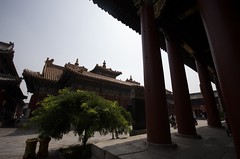Yonghe Gong, aka the Lama Temple, is the largest Tibetan Buddhist temple in China – it’s an impressive, if predictable, site (tiled roofs, red columns, gates, halls) which somehow survived the Cultural Revolution without being bulldozed. The exact details of how this occurred seem to be slightly mysterious and not dwelt upon by the literature. The ancient Buddhist monks helpfully sited their temple next to a metro stop, something the emperors should really have paid more attention to. ((We managed it in Edinburgh, as the apocryphal American tourist pointed out – “It’s great that they built the castle so close to the train station”))
Â
Architecturally, the place is large but not sprawling – a relatively dense collection of temples, courtyards and halls – there’s none of the vast open spaces of the Forbbiden City, instead there’s a succession of much more compact squares, each containing trees, shrines, statues and huge, smoking incense pots. Each hall contains multiple Buddhas in various poses, and despite being a tourist-trap many visitors are actively praying before them. The street outside is lined with shops selling large bundles of incense, and inside the air is thick with the smell – it seems that the efficacy of the prayer must be correlated to the tonnage of material being burned.

